How Mikaela Shiffrin Sharpened Her Mental Edge
RELATED: Our Best World Cup Stories
For the second year in a row, Mikaela Shiffrin swept the field to win the slalom at the World Cup at Killington. But this year there was something different. It wasn’t that she smoked the field on both runs, amassing a whopping 1.64 second lead over Slovakia’s Petra Vhlova — a margin so big that it was larger than the difference between Vhlova and 14th place finisher, University of Vermont junior Laurence St. Germain.

It wasn’t that the course was rock hard, icy and fast—“the iciest course I’ve skied,” said announcer and former Olympic ski racer Doug Lewis, of Waitsfield. It wasn’t that the fan base was, if possible, even larger than last year. It wasn’t that she’d scored second in the giant slalom the day before, versus fifth here last year.
It came down to this: “Last year I was reeling and almost incapacitated by nerves. This year, those nerves fueled me. And I wasn’t puking before races.”
As hard as it is to believe, Mikaela Shiffrin, the 22-year-old phenom who won her first World Cup race when she was 17 and still training at Burke Mountain Academy, still gets really nervous before races, to the point of anxiety attacks.
“Sometimes I wake up and there’s a dark cloud around me. I know logically all I have to do is ski. But it feels like I can’t breathe. Last year I was puking before races. But this year I haven’t puked. I’m starting to find a way to control it.”
Last season, Shiffrin began working with a sports psychologist. I asked her what helped, what has made a difference. “I picture the cloud and then I am able to blow it away,” she said, adding, “My mom helps, my sports psychologist helps and I’m trying to find a way to believe in myself even if I don’t feel totally confidant. Of course, skiing really well helps too.”

“Skiing well” would have been an understatement when it came to describing Shiffrin’s runs today. To watch Shiffrin snake down through the gates today was like watching a stream run down a mountain. “She never goes farther than she has to,” said Vermont’s Marilyn Cochran Brown, a judge, gatekeeper and former World Cup season winner. “She pressures the front of her skis and then carves every turn, picking up speed.” Barbara Ann Cochran, Marilyn’s sister and the 1972 slalom Olympic slalom gold medalist who was gatekeeping farther down the course, added “She’s completely still with her upper body, her shoulders always square and quiet.” The Cochran sisters, along with brother Bobby Cochran and a half dozen other former World Cup racers were gatekeepers and Stowe’s Mount Mansfield Ski Club director Igor Vanovac was the Chief of Course.
Running last, with all the teams and fans gathered at the base, it was as if Shiffrin was demonstrating what skiing should be. “She’s the best slalom racer – of women – I’ve ever seen,” said Pam Fletcher, who raced World Cup in the 1980s and has been a race commentator. What made her so good? “She spent hours and hours watching videos of Ted Ligety and focusing on how he carved. She’s put the time in in the gym, and she has a solid team around her that really works as a team. Her mom, Eileen really is her coach and helps her stay focused, she has a good agent, she has a great tech team. People often don’t realize how much of the behind the scenes go into making a great racer” says Fletcher. “Mikaela has it all.”
Mike Day, the former Green Mountain Valley School coach from Waitsfield, has been coaching Shiffrin since last year. Day, who had been recovering from surgery, made it to Killington in time for the races. “Our team is so tight that when one person had to leave or fly home for a while we have a reentry process,” Shiffrin joked, adding “It’s great to have him back and to have the whole team together and the whole team healthy.”
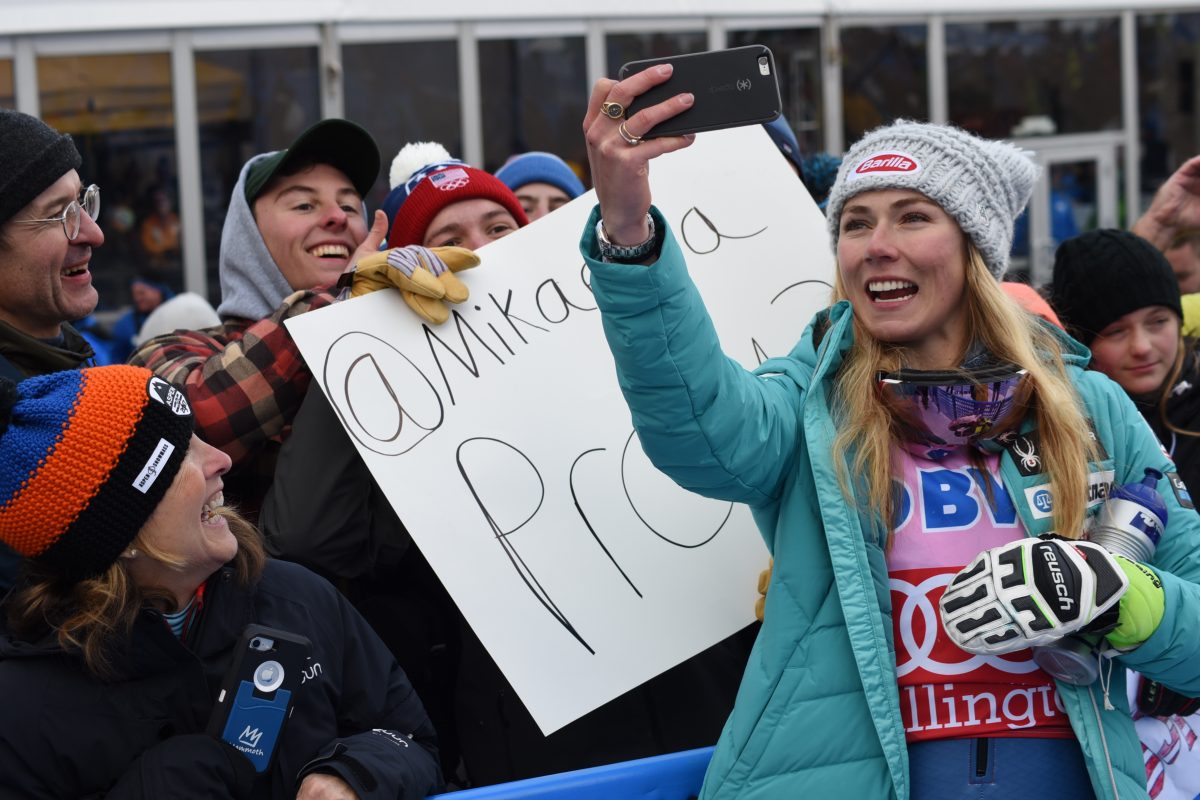
Part of Shiffrin’s training this season involved skiing gates with one of her closest competitors, Petra Vhlova. The two trained together in Levi, Finland, prior to the first slalom World Cup event, one where Vhlova won and Shiffrin finished second. “It’s going to be a really cool rivalry,” Shiffrin said. “After the training she came up to me and put a hand on my shoulder and said ‘Thank you so much for the training with me.’ I was fuming because I hate training with any one so close to me. And that totally changed things – it was like, that’s how I should be. It was like competing against Roger Federer: you really want to hate him but you can’t. This girl is working hard and skiing with discipline. And it shows.” Shiffrin added, “Since then I found this really balanced stance and put that out there.”
Resi Stiegler, a Jackson Hole skier, was the only other American to make it to the second run, but a Vermont part-timer did as well.
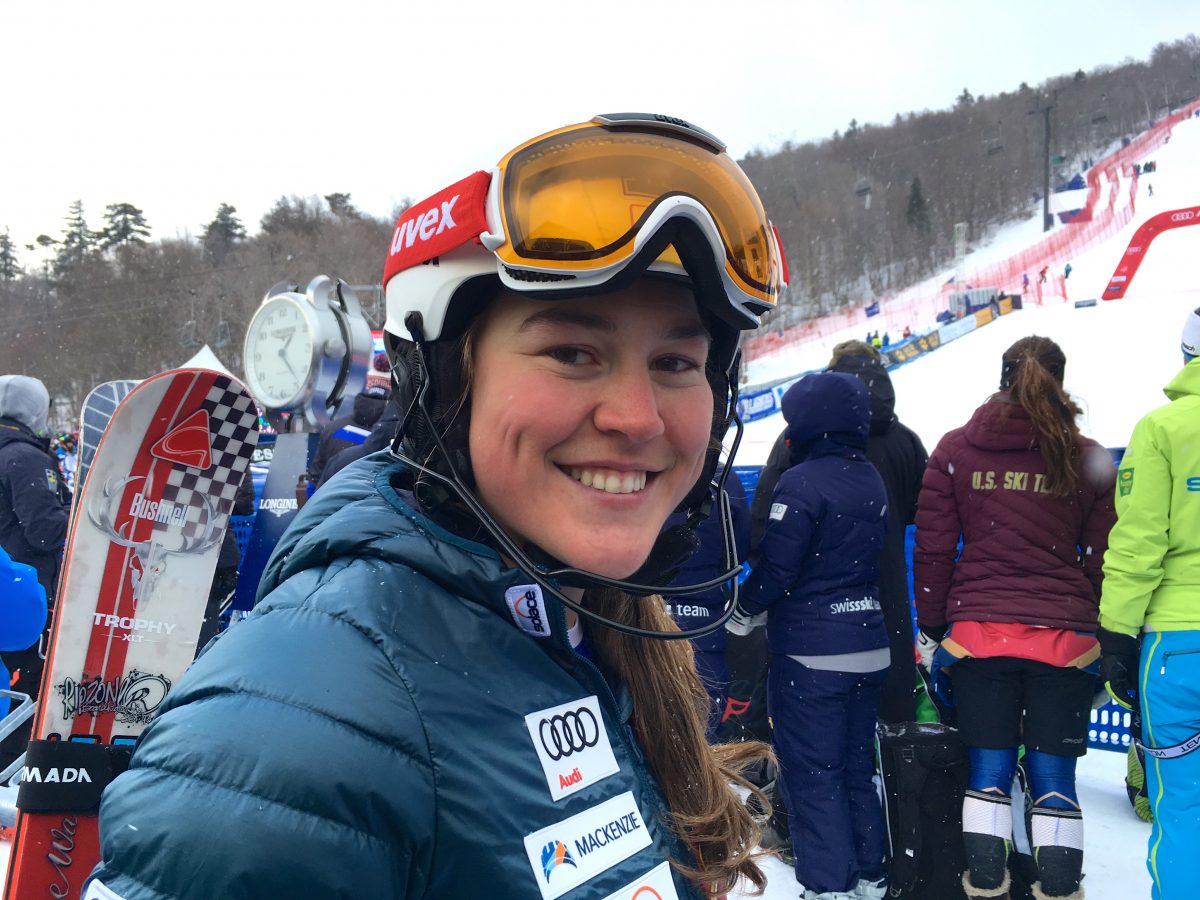
For about 20 minutes University of Vermont junior Laurence St. Germain was on the top of the world. Or at least on top of the leader board. In her second season on the World Cup tour, the Canadian skier finally broke into the top 30 on her first run. “I was sitting in 28th for a long time and so nervous,” she said. Breaking into the top 30 would earn a second run, World Cup points and put her closer to making the Canadian Olympic team. “I would need two top 12 finishes or one finish in the top 7 to automatically make it,” St. Germain said of her Olympic dreams. She was the only Canadian to make it to the second run today.
“Still, it’s my first time getting a second run in a World Cup,” she said, happy and breathless as she watched the racers times flash on the big screen in the finish area.
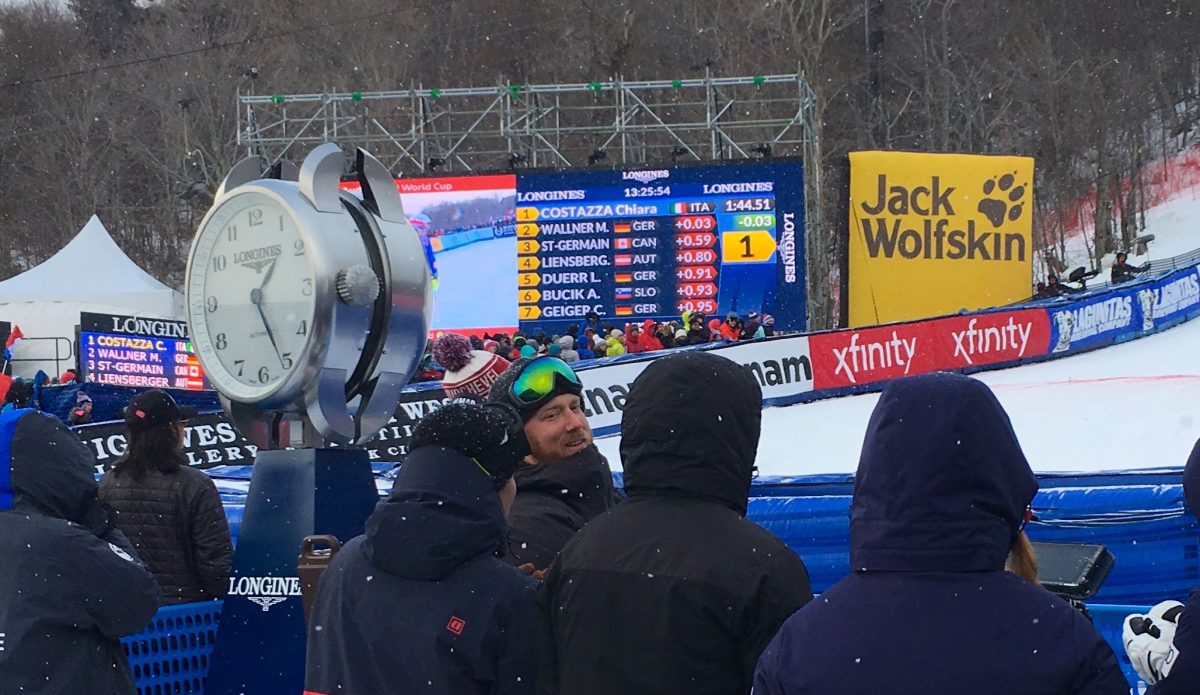
Finishing 28th meant St. Germain would then start the second run third. As the crowds in the finish area screamed she blazed down the course, the screen showing her splits and showing she was leading at every one. When she finally blasted through the finish she saw her name at the top of the board. And for about 20 minutes it stayed there.
The excitement in a World Cup race comes in the second half as one by one, a new racer takes the lead, knocking the others down the ranks like dominoes. St. Germain, or “LoLo” as friends call her, held her lead for about 20 minutes before getting knocked down to second, then third. She ended up fourteenth, only 1.52 seconds behind second place Vhlova, but 4.19 seconds behind Shiffrin. That’s how far ahead Shiffrin was.
RESULTS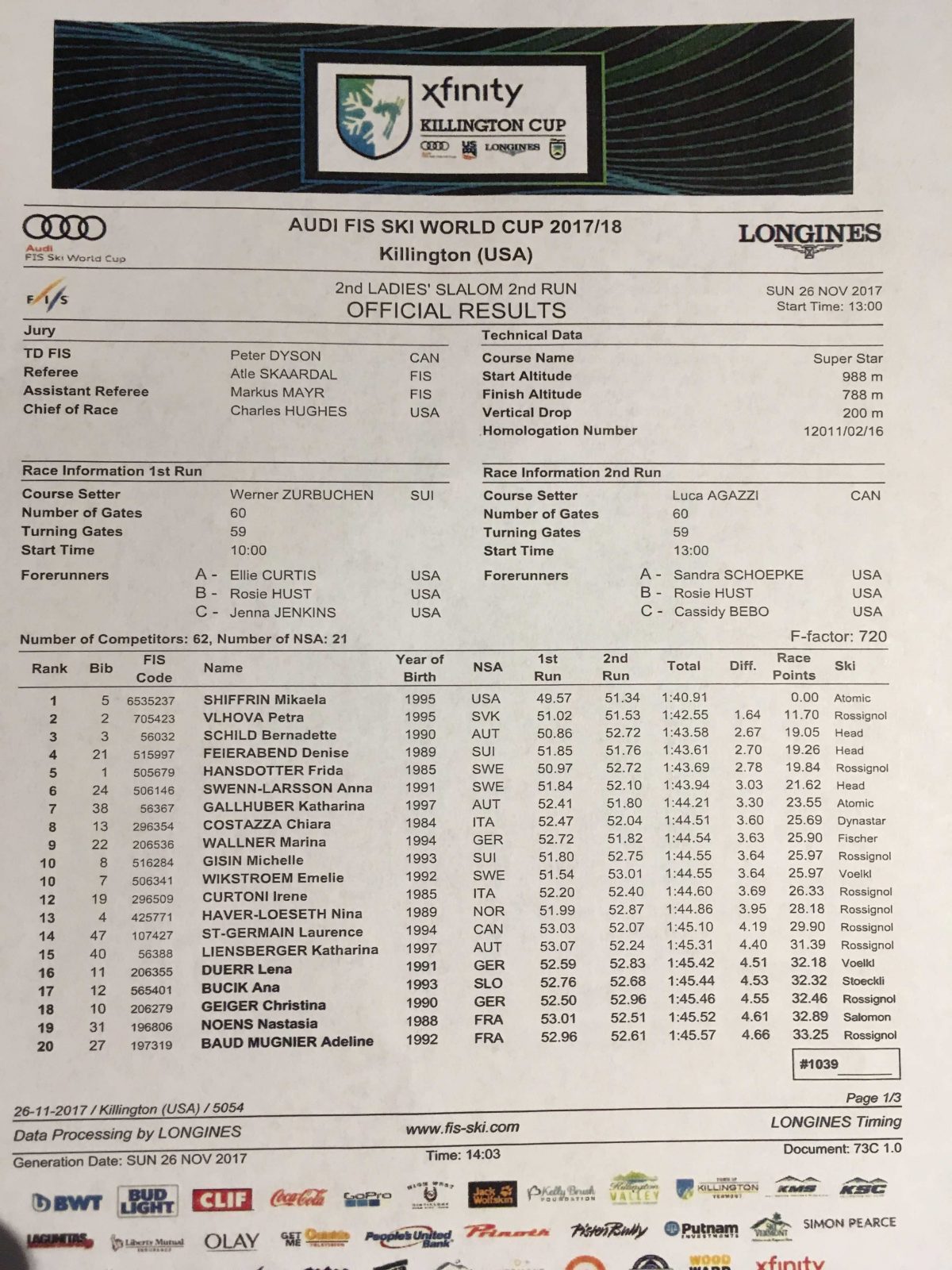

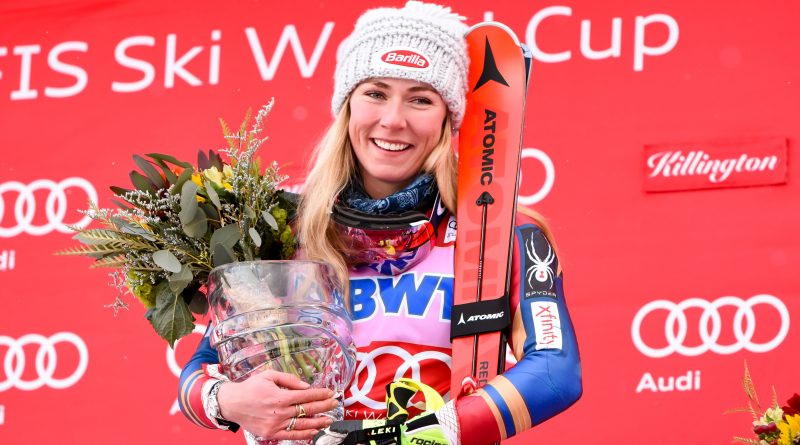
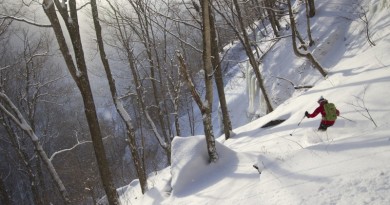
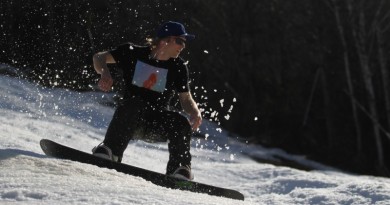

Pingback: Our Best World Cup Stories - VT SKI + RIDE